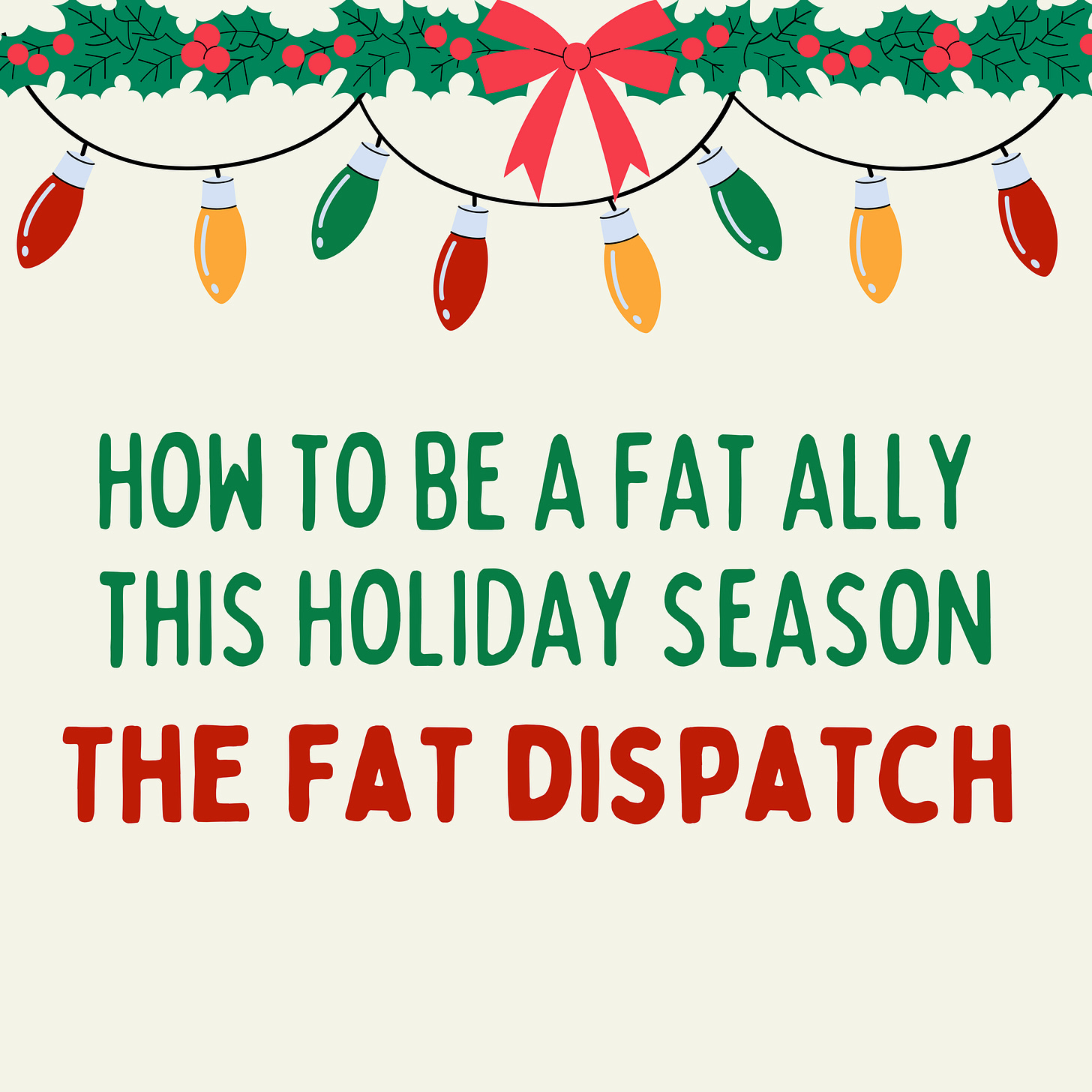How to be a Fat Ally
Especially this holiday season, your presence and words can be revolutionary in the lives of the people around you
Recently, a member of my All Bodies Are Good Bodies Facebook group requested a special topic for this newsletter. Laura wrote:
“I personally want to hear how people living with thin privilege can best support their fat friends, both in person and behind the scenes. I realize that isn't the responsibility of others to teach, but I'm always looking for more resources about this and appreciate when anyone is willing.”
I’m very willing!
Let’s start with the concept of size privilege.
Size privilege is the reality that people in smaller bodies in a given group hold more cultural power than those in larger bodies. Since size is culturally associated with worthiness, the smaller you are, the more cultural acceptance and power you have. This is relative—a size 14 in a room of size 6s holds less cultural power than a size 14 in a room of size 26s, if that makes sense.
If you’re aware of your size privilege in any given situation, you can leverage your cultural advantage to speak up for people bigger than you.
Now let’s talk about Fat Liberation.
What is Fat Liberation? Fat Liberation is a social justice movement which has the goal of liberating people in every body from injustice, whether that be size discrimination or another form of discrimination (gender, sexuality, ethnic, race, etc.). It’s the idea that people of any body size deserve to have their human dignity recognized and to be treated with decency, without the expectation that they change their body (i.e. to make it smaller).
I can see four distinct levels of Fat Liberation: personal, interpersonal, community-based, and structural.
The Personal: what goes on inside our heads.
The Interpersonal: what happens between two people.
The Community: what occurs within a group of people.
The Infrastructure: what is systematically set up in a society.
Because anti-fatness exists at every level, we have to aim our efforts toward each one individually.
Personal: Feel like you take up too much space? Concerned about looking fat? Wondering why a thin person would ever partner with a fat person? These are all common examples of anti-fatness at the personal level. To bring fat liberation to the personal level means challenging those mental positions and replacing them with fat-positive affirmations. Feeling like you’re taking up too much space is countered by the affirmation “I have the right to take up space.” Concern about looking fat is countered by the affirmations “All bodies are good bodies” or “it’s okay to be fat.” Speculation about different sizes of people partnering together is countered by the affirmation “Fatness is beautiful.” Of course, these are just options for what your affirmations could look like.
Interpersonal: Conversations with others are where interpersonal fat liberation occurs. For starters, never comment on someone’s body, even if you think you’re being complimentary. If you hear someone commenting on yours or another body, speak up: “We don’t comment about people’s bodies, thanks.” Negative comments about weight gain or loss are obviously detrimental to the recipient. Much more insidious are the praises of weight loss—you never know what someone is going through that might cause their body to shift, so steer conversations toward personality traits or non-body things like accessories.
Community-based: Group gatherings, whether that’s with family or in a place of worship, can be filled with anti-fat landmines. It’s so easy for a group’s culture to simply reflect the anti-fatness of culture at large. If you hear a leader or a respected member of the community contributing to anti-fatness, please challenge them directly or pull them aside for a course correct, saying something like, “I’m not sure you know, but the comment you made about deserving dessert/punishing ourselves for ‘overeating’ can be connected to disordered eating. Please don’t make offhand or direct comments about anyone’s food choices.”
Structural: Anti-fatness at the structural level is usually couched in terms of health and wellness. Examples of structural anti-fatness could look like these scenarios: “Someone denied life insurance because of their CPAP? Should have been healthier.” “Someone earn a BMI bonus through their work insurance plan? They’ve earned it.” “Someone rejected for surgery because of their BMI? It’s too dangerous.” These are systemic ways that fat people are excluded and isolated from healthcare and basic decency.
During the holidays, you will probably encounter a lot of levels 1, 2, and 3. Having scripts or prompts is really helpful in those situations. Think of what you will say to your cousin who can’t stop commenting on everyone’s food choices. Maybe something like this: “Food is morally neutral; please stop moralizing it,” or “Please keep your opinions of others’ food choices to yourself.”
Becoming a good fat ally takes some work, but it is worth the labor—not only for your fat friends but for you! Our liberation is bound up together!
For liberation, together!
Amanda Martinez Beck
P.S. For further reading about the 4 levels of fat liberation, check out my book More of You: The Fat Girl’s Field Guide to the Modern World (available wherever you get books).




